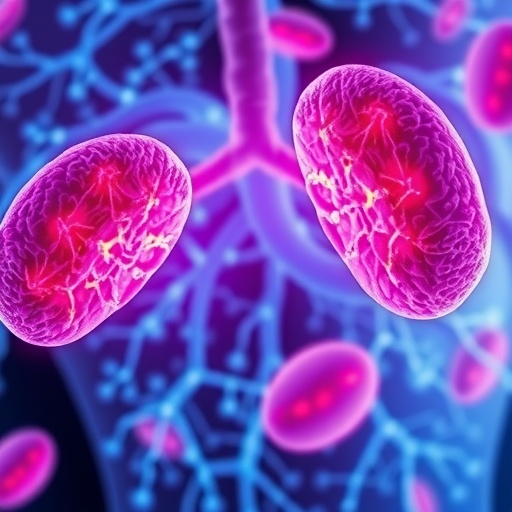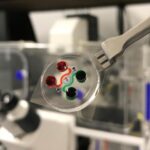
In a groundbreaking study published in BMC Cancer, researchers have made strides in understanding and predicting liver injury induced by immune checkpoint inhibitors (ICIs) in patients suffering from hepatocellular carcinoma (HCC). As ICIs revolutionize systemic cancer therapies, their unintended hepatic side-effects emerge as significant clinical challenges. This retrospective analysis offers new insights into the risk factors and timing of immune-mediated liver injury, potentially aiding oncologists in preemptive identification and management of such adverse events.
Immune checkpoint inhibitors have radically transformed the landscape of cancer treatment by harnessing the patient’s own immune system to target and destroy cancer cells. However, by activating immune responses, these therapies can sometimes provoke immune-related adverse events, including liver injury, complicating treatment outcomes. Hepatocellular carcinoma, the predominant form of liver cancer, presents a unique case where the liver is not only the primary malignancy site but also the organ affected by the treatment’s toxicity, posing a challenge to maintaining therapeutic regimens.
This study retrospectively examined clinical data from 207 inpatients diagnosed with hepatocellular carcinoma who underwent treatment with ICIs. Researchers specifically aimed to identify which patients developed immune-mediated liver injury, categorized as ILICI, and to discern patterns and predisposing factors influencing its occurrence. Patients were stratified into two groups: those who experienced liver injury following ICI therapy and those who did not, enabling comparative analysis.
.adsslot_3rvAgVqc4e{width:728px !important;height:90px !important;}
@media(max-width:1199px){ .adsslot_3rvAgVqc4e{width:468px !important;height:60px !important;}
}
@media(max-width:767px){ .adsslot_3rvAgVqc4e{width:320px !important;height:50px !important;}
}
ADVERTISEMENT
The incidence of ILICI was observed to be 25.1%, indicating that one in four HCC patients receiving ICIs may be affected by this complication. Notably, the liver injury typically manifested within four to twelve weeks after therapy initiation, highlighting a critical window during which vigilant monitoring is paramount. This temporal pattern underscores the importance of ongoing hepatic assessment during the early phase of immune checkpoint inhibitor treatment.
Detailed classification of liver injury in these patients revealed a predominance of cholestatic patterns, accounting for 65.4% of cases, while hepatocellular and mixed injury types accounted for 11.5% and 23.1%, respectively. Cholestasis refers to impaired bile flow leading to accumulation of bile acids, which can exacerbate liver damage, whereas hepatocellular injury involves direct damage to liver cells. The mixed pattern encompasses features of both, reflecting the heterogeneity of immune-mediated hepatotoxicity.
Severity assessments revealed that the majority of cases, approximately 76.9%, were mild, suggesting that while ILICI is relatively common, extreme cases necessitating aggressive interventions are less frequent. Nonetheless, even mild hepatic injury can necessitate interruption or suspension of potentially life-saving cancer therapies, emphasizing the clinical significance of early identification and management.
Through multivariate logistic regression analysis, the study identified three main risk factors significantly associated with the onset of ILICI in HCC patients. Diabetes emerged as a notable contributor, with diabetic individuals exhibiting an over threefold increased risk of liver injury compared to non-diabetics. The interplay between metabolic dysregulation and immune response modulation may underlie this enhanced susceptibility, warranting further investigation.
Liver cirrhosis stood out as another formidable risk factor with an odds ratio exceeding six, suggesting that pre-existing liver scarring dramatically heightens vulnerability to immune-mediated hepatic damage. Considering that cirrhosis compromises hepatic reserve and regenerative capacity, its presence likely exacerbates toxicity from ICIs. This finding urges clinicians to apply heightened caution when administering ICIs to cirrhotic patients.
Furthermore, patients with multiple hepatic nodules, defined as three or more tumor lesions, were at significantly higher risk of ILICI, reinforcing the concept that tumor burden influences immune activation and hepatic tolerance. Extensive disease might amplify inflammatory signaling and immune cell infiltration, precipitating collateral liver injury. This insight potentially refines patient selection and monitoring protocols.
Building upon these predictive factors, the researchers constructed a logistic model aimed at forecasting the likelihood of ILICI occurrence before clinical onset. This model yielded a receiver operating characteristic area under the curve (AUC) of 0.701, reflecting moderate discriminative power. Sensitivity and specificity values were balanced at approximately 71% and 63%, respectively, indicating the model’s potential utility as a clinical tool, albeit with limitations.
The predictive model’s positive predictive value was 0.720, signifying that nearly three out of four patients identified as high risk did develop liver injury. Correspondingly, the negative predictive value of 0.630 suggests that nearly two-thirds of those classified as low risk remained free from ILICI. These statistics propose that while the model is not infallible, it offers meaningful guidance in stratifying patients and tailoring surveillance intensity.
Understanding the pathophysiological mechanisms behind ILICI is vital for advancing therapeutic strategies. ICIs modulate immune checkpoints such as PD-1 and CTLA-4 to unleash antitumor immunity but can inadvertently trigger autoimmune-like responses against healthy hepatocytes or biliary structures. The predominance of cholestatic liver injury points to bile duct involvement or immune-mediated cholangiopathy as potential pathways in this toxicity.
Current clinical management of ILICI prioritizes early detection through biochemical liver function tests, followed by corticosteroid therapy to quell inflammation when injury is moderate to severe. However, steroids can compromise anticancer efficacy and introduce adverse effects, underscoring the necessity for predictive tools to preempt injury and inform therapeutic decisions. This study’s findings pave the way for integrating risk stratification into clinical algorithms.
Future research could expand on these findings by incorporating molecular biomarkers and imaging data to refine prediction accuracy. Prospective studies may validate and enhance the model’s applicability across diverse patient populations and ICIs regimens. Moreover, elucidating the immunological underpinnings of ILICI could inspire targeted interventions that minimize hepatic toxicity without diminishing antitumor benefits.
In sum, this rigorous retrospective analysis offers valuable clinical insights into the incidence, timing, and risk determinants of immune checkpoint inhibitor–induced liver injury in hepatocellular carcinoma. By proactively identifying high-risk patients through an evidence-based model, clinicians can better navigate the delicate balance between optimizing cancer control and safeguarding liver health—a critical advance in the evolving era of immuno-oncology.
The data highlight that despite the relative commonness of ILICI, the clinical severity tends to be mild, which is reassuring but should not diminish clinical vigilance. For HCC patients harboring diabetes, liver cirrhosis, or multiple tumor nodules, intensified monitoring and possibly tailored therapeutic regimens may mitigate risks. This nuanced understanding aligns with personalized medicine principles, aiming to maximize therapeutic efficacy while minimizing harm.
As immune checkpoint blockade becomes increasingly integral to HCC management, quantifying and predicting immune-related hepatic adverse effects will remain a pivotal research and clinical focus. This study marks an important step in stratifying patients and optimizing care pathways, ultimately striving for improved survival and quality of life for this vulnerable patient population.
Subject of Research: Prediction and risk factors of immune checkpoint inhibitor–induced liver injury in hepatocellular carcinoma patients.
Article Title: Predicting the occurrence of liver injury induced by immune checkpoint inhibitors in hepatocellular carcinoma patients: a retrospective analysis.
Article References:
Li, X., Sun, H., Wang, J. et al. Predicting the occurrence of liver injury induced by immune checkpoint inhibitors in hepatocellular carcinoma patients: a retrospective analysis. BMC Cancer 25, 1123 (2025). https://doi.org/10.1186/s12885-025-14540-y
Image Credits: Scienmag.com
DOI: https://doi.org/10.1186/s12885-025-14540-y
Tags: adverse effects of cancer immunotherapyclinical insights into liver toxicityhepatocellular carcinoma treatment challengesimmune checkpoint inhibitors in liver cancerimmune-mediated liver injury risk factorsimmune-related adverse events in cancer therapyliver injury complications in ICIsoncologist management of liver side effectspatients with hepatocellular carcinomapredicting liver injury from immunotherapypreemptive identification of liver toxicityretrospective analysis of liver injury



